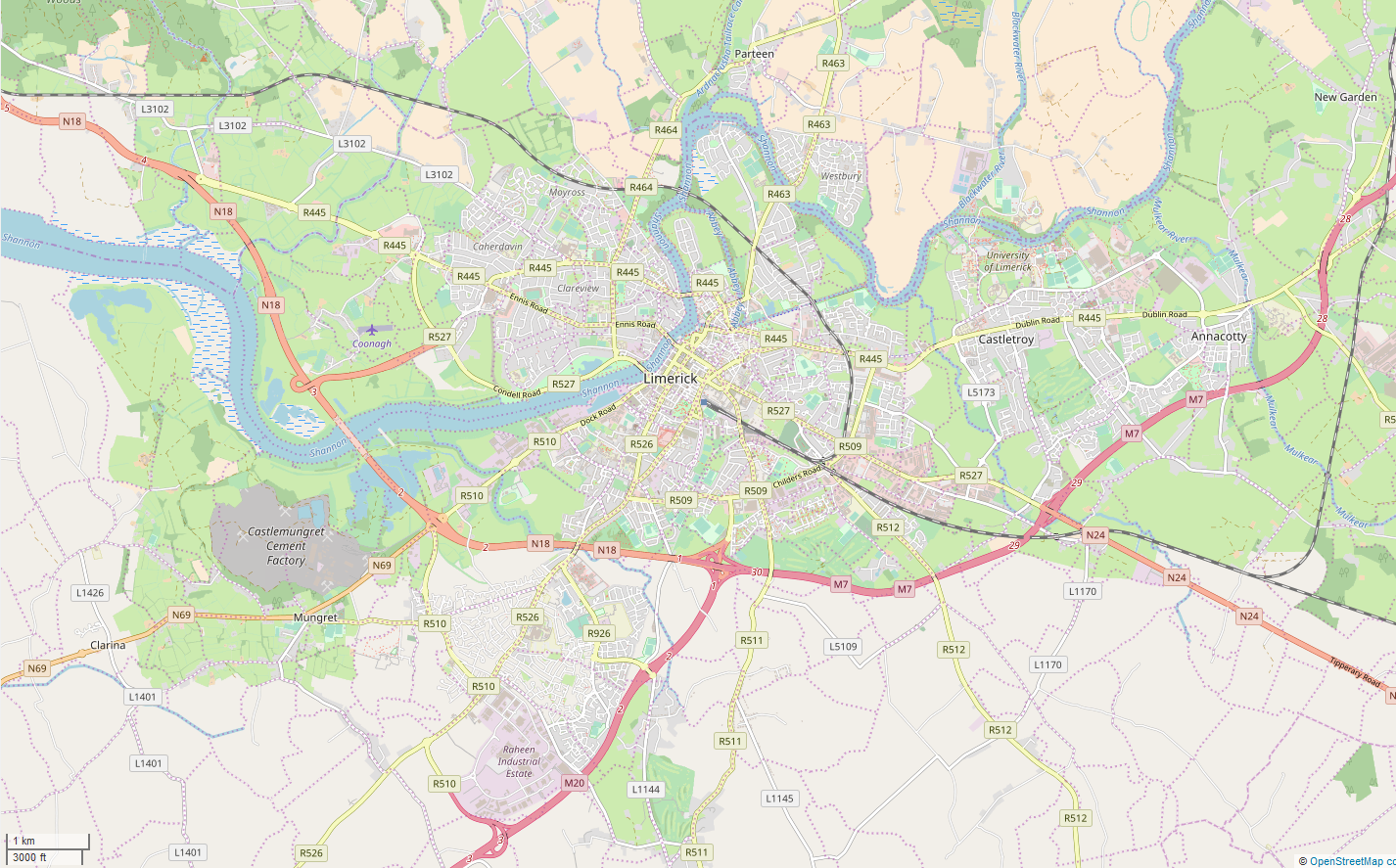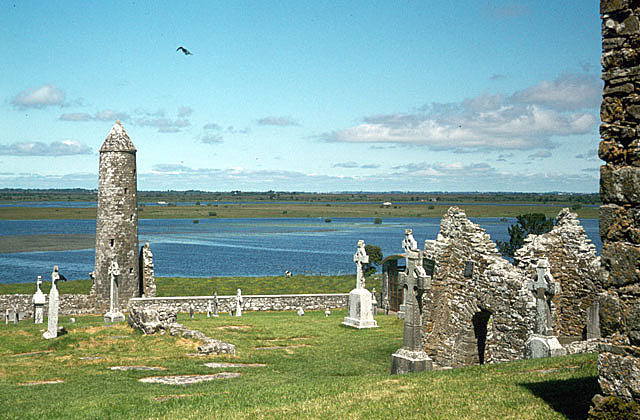|
Kildimo
Kildimo () is a village in County Limerick, Ireland. The village is close to the Shannon estuary, 13 km west of Limerick city, on the N69 road. The population was 417 at the 2016 census. Kildimo/Pallaskenry Parish The parish of Kildimo/Pallaskenry is in the barony of Kenry. The present-day parish is made up of what were once the parishes of Kildimo, Ardcanny and Chapelrussell. Chapelrussell parish was once called Killuragh, Killenalotar or Killulta. The name Kildimo comes from the Irish Cill Díoma, meaning the church of St Díoma. The old people of the parish used to pronounce the name 'Kildeema'. According to Mainchín Seoige, St Díoma is said to have flourished in the second half of the 5th century. He was reputedly of royal stock, the son of Cas, king of Munster, and an uncle of St Munchin, patron of the diocese of Limerick. His feast day is 12 May. Pallaskenry comes from the Irish Pailís Chaonraí meaning 'The Palisaded Fortress of Kenry'. The Caonraighe were a Ga ... [...More Info...] [...Related Items...] OR: [Wikipedia] [Google] [Baidu] |
Kenry
Kenry (: ) is a historical barony in northern County Limerick, Ireland. Baronies were mainly cadastral rather than administrative units. They acquired modest local taxation and spending functions in the 19th century before being superseded by the Local Government (Ireland) Act 1898. History The barony takes its name from the Gaelic Irish , "Cáen's tribe." The Cáenraige were ruled by the Uí Fidgenti from the 3rd to 10th centuries AD, when the Ó Donnabháin (Donovans) took it from them; they were rulers of the Uí Chairbre prior to this and their new territory became known as Caonraighe Ui Chaibre. In the 12th century, Donal Mor O'Brien and the Anglo-Normans drove the Donovans into West Cork and Kerry. Kenry gave its name to Kenry Castle, which in turn gave its name to Pallaskenry ("palisade of Kenry"). The Book of Lecan connects Kenry to the legendary harper Uaithne, with his sons Uaithnia, Druithnia and Caínnia being the ancestors of the Uaithni, Dál Druithne and ... [...More Info...] [...Related Items...] OR: [Wikipedia] [Google] [Baidu] |
N69 Road (Ireland)
The N69 road is a national secondary road in Ireland. It runs from Limerick to Tralee and passes through Mungret, Clarina, Kildimo, Askeaton (bypassed), Foynes, Loghill, Glin, Tarbert, and Listowel. Upgrades The N22/N69 Tralee Bypass opened on 16 August 2013. Four kilometres of dual carriageway were added to the N69, the first such section to be included in this route. The N69 now terminates at the Ballingowan Roundabout on the N22/N69 Tralee Bypass. In August of 2024, the N69 Listowel Bypass opened. It is a six kilometre single carriageway around the north and west of the town. Route The N69 starts in Limerick on the N18 West Limerick Bypass, which was opened in 2010. It then passes though the villages of Mungret, Clarina, Ferrybridge and Kildimo. This section of N69 is the busiest with average traffic volumes of up to 8,000 daily. It passes by Askeaton, which has been bypassed since 1990. It then passes through the port town of Foynes and the villages of Log ... [...More Info...] [...Related Items...] OR: [Wikipedia] [Google] [Baidu] |
List Of Towns And Villages In The Republic Of Ireland
This is a link page for cities, towns and villages in the Republic of Ireland, including townships or urban centres in Dublin, Cork, Limerick, Galway, Waterford and other major urban areas. Cities are shown in bold; see City status in Ireland for an independent list. __NOTOC__ A B C D E F G H I J K L M N O P Q R S T U V W Y See also * List of places in Ireland ** List of places in the Republic of Ireland **List of urban areas in the Republic of Ireland as defined by the Central Statistics Office. Includes non-municipal towns and suburbs outside municipal boundaries *** List of urban areas in the Republic of Ireland/2011 census *** List of urban areas in the Republic of Ireland/2006 census *** List of urban areas in the Republic of Ireland/2002 census ** List of cities, boroughs and towns in the Republic of Ireland, with municipal councils and legally defined boundaries up to 2014 ... [...More Info...] [...Related Items...] OR: [Wikipedia] [Google] [Baidu] |
County Limerick
County Limerick () is a western Counties of Ireland, county in Republic of Ireland, Ireland. It is in the Provinces of Ireland, province of Munster and is located in the Mid-West Region, Ireland, Mid-West which comprises part of the Southern Region, Ireland, Southern Region. It is named after the city of Limerick. Limerick City and County Council is the Local government in the Republic of Ireland, local council for the county. The county's population at the 2022 census was 209,536 of whom 102,287 lived in Limerick City, the county capital. Geography Limerick borders four other counties: County Kerry, Kerry to the west, County Clare, Clare to the north, County Tipperary, Tipperary to the east, and County Cork, Cork to the south. It is the fifth-largest of Munster's six counties in size and the second-largest by population. The River Shannon flows through the city of Limerick, then continues as the Shannon Estuary until it meets the Atlantic Ocean past the far western end of the c ... [...More Info...] [...Related Items...] OR: [Wikipedia] [Google] [Baidu] |
Republic Of Ireland
Ireland ( ), also known as the Republic of Ireland (), is a country in Northwestern Europe, north-western Europe consisting of 26 of the 32 Counties of Ireland, counties of the island of Ireland, with a population of about 5.4 million. Its capital city, capital and largest city is Dublin, on the eastern side of the island, with a population of over 1.5 million. The sovereign state shares its only land border with Northern Ireland, which is Countries of the United Kingdom, part of the United Kingdom. It is otherwise surrounded by the Atlantic Ocean, with the Celtic Sea to the south, St George's Channel to the south-east and the Irish Sea to the east. It is a Unitary state, unitary, parliamentary republic. The legislature, the , consists of a lower house, ; an upper house, ; and an elected President of Ireland, president () who serves as the largely ceremonial head of state, but with some important powers and duties. The head of government is the (prime minister, ), ... [...More Info...] [...Related Items...] OR: [Wikipedia] [Google] [Baidu] |
Limerick
Limerick ( ; ) is a city in western Ireland, in County Limerick. It is in the Provinces of Ireland, province of Munster and is in the Mid-West Region, Ireland, Mid-West which comprises part of the Southern Region, Ireland, Southern Region. With a population of 102,287 at the 2022 census of Ireland, 2022 census, Limerick is the List of urban areas in the Republic of Ireland, third-most populous urban area in Republic of Ireland, Ireland, and the List of settlements on the island of Ireland by population, fourth-most populous city on the island of Ireland. It was founded by Scandinavian settlers in 812, during the Viking Age. The city straddles the River Shannon, with the historic core of the city located on King's Island, Limerick, King's Island, which is bounded by the Shannon and Abbey River, Limerick, Abbey Rivers. Limerick is at the head of the Shannon Estuary, where the river widens before it flows into the Atlantic Ocean. Limerick City and County Council is the Local gov ... [...More Info...] [...Related Items...] OR: [Wikipedia] [Google] [Baidu] |
Earl Of Limerick
Earl of Limerick is a title that has been created twice in the Peerage of Ireland, associated first with the Dongan family, then with the Pery family. It should not be confused with the title Viscount of the City of Limerick (usually shortened to Viscount of Limerick, or Lord Limerick) held by the Hamilton family, also Earls of Clanbrassil. First creation The earldom was created for the first time in 1686 for Sir William Dongan, 4th Baronet, with remainder, failing male issue of his own, to his brothers Robert, Michael and Thomas and the heirs male of their bodies. He had been made Viscount Dungan, of Clane in the County of Kildare in 1661, also in the Peerage of Ireland and with similar remainder. His only son Walter Dungan, Viscount Dungan, was killed at the Battle of the Boyne and Lord Limerick was succeeded according to the special remainders (and normally in the baronetcy) by his brother Thomas Dongan, 2nd Earl of Limerick, Thomas Dongan, the second Earl. He was List of ... [...More Info...] [...Related Items...] OR: [Wikipedia] [Google] [Baidu] |
Western European Summer Time
Western European Summer Time (WEST, UTC+01:00) is a summer daylight saving time scheme, 1 hour ahead of Greenwich Mean Time and Coordinated Universal Time. It is used in: * the Canary Islands * Portugal (including Madeira but not the Azores) * the Faroe Islands The following countries also use the same time zone for their daylight saving time but use a different title: *United Kingdom, which uses British Summer Time (BST) *Ireland, which uses Irish Standard Time (IST) ( (ACÉ)). Also sometimes erroneously referred to as "Irish Summer Time" (). The scheme runs from the last Sunday in March to the last Sunday in October each year. At both the start and end of the schemes, clock changes take place at 01:00 UTC+00:00. During the winter, Western European Time (WET, GMT+0 or UTC+00:00) is used. The start and end dates of the scheme are asymmetrical in terms of daylight hours: the vernal time of year with a similar amount of daylight to late October is mid-February, well before th ... [...More Info...] [...Related Items...] OR: [Wikipedia] [Google] [Baidu] |
River Shannon
The River Shannon ( or archaic ') is the major river on the island of Ireland, and at in length, is the longest river in the British Isles. It drains the Shannon River Basin, which has an area of , – approximately one fifth of the area of Ireland. Known as an important waterway since antiquity, the Shannon first appeared in maps by the Graeco-Egyptian geographer Ptolemy ( 100 – 170 AD). The river flows generally southwards from the Shannon Pot in County Cavan before turning west and emptying into the Atlantic Ocean through the long Shannon Estuary. Limerick city stands at the point where the river water meets the sea water of the estuary. The Shannon is tidal east of Limerick as far as the base of the Ardnacrusha dam. The Shannon divides the west of Ireland (principally the province of Connacht) from the east and south (Leinster and most of Munster; County Clare, being west of the Shannon but part of the province of Munster, is the major exception.) The river rep ... [...More Info...] [...Related Items...] OR: [Wikipedia] [Google] [Baidu] |
Provinces Of Ireland
There are four provinces of Ireland: Connacht, Leinster, Munster and Ulster. The Irish language, Irish word for this territorial division, , meaning "fifth part", suggests that there were once five, and at times Kingdom of Meath, Meath has been considered to be the fifth province. In the medieval period, however, there were often more than five. The number of provinces and their delimitation fluctuated until 1610, when they were permanently set by the English administration of James VI and I, James I. The provinces of Ireland no longer serve administrative or political purposes but function as historical and cultural entities. Etymology In modern Irish language, Irish, the word for province is (pl. ). The modern Irish term derives from the Old Irish (pl. ) which literally meant "a fifth". This term appears in 8th-century law texts such as and in the legendary tales of the Ulster Cycle where it refers to the five kingdoms of the "Pentarchy". MacNeill enumerates the five earl ... [...More Info...] [...Related Items...] OR: [Wikipedia] [Google] [Baidu] |



